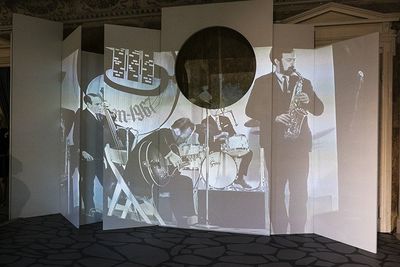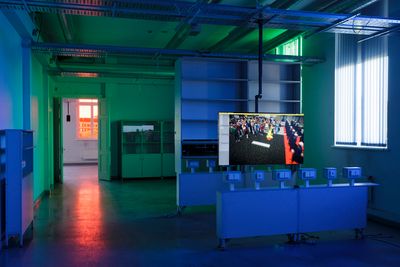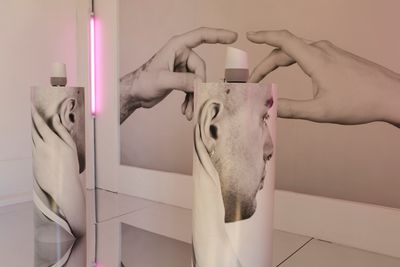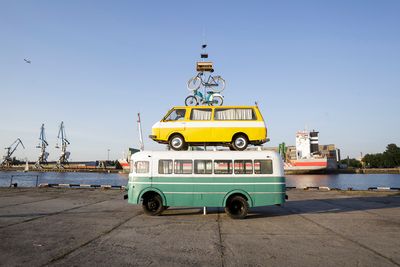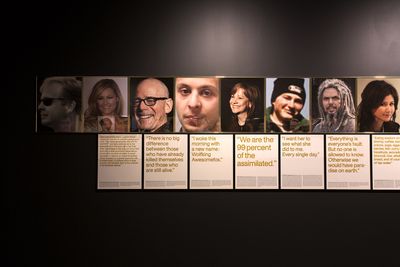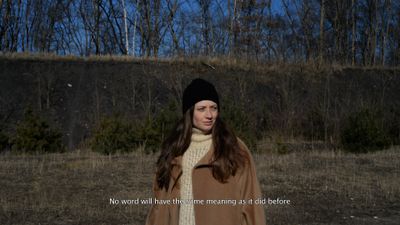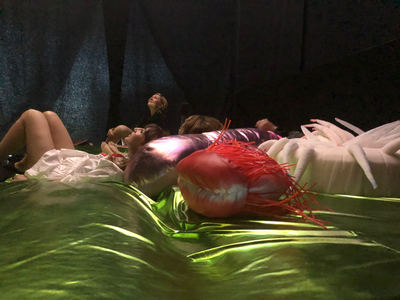RIBOCA 2018: Riga’s first biennial gives time to change

Kerstin Hamilton, Zero Point Energy (2016) (Still). Single-channel video, colour, sound. 18 min 39 sec. Supported by Hasselblad Foundation, Chalmers University of Technology, Lund University and Valand Academy. Courtesy the artist.
In early 2017, a presentation for the first Riga International Biennial of Contemporary Art (RIBOCA) circulated on Facebook, and a discussion unfolded over the private Russian backing behind the project, and the absence of Latvian institutional (or state) support. The relationship between Russia and the formerly Soviet Baltic states has become ever more tense since the annexation of the Crimea in 2014; that RIBOCA 1 (2 June–28 October 2018) was to launch one year before the centennial of Latvia's establishment as a republic only heightened dynamics.
With that in mind, Katerina Gregos's appointment as RIBOCA's inaugural curator was a deft choice. The curator has a knack for going into a context, identifying core themes emanating from its history, and making them resonate globally. RIBOCA 1's title, Everything Was Forever Until It Was No More, comes from Alexei Yurchak's 2006 book about the Soviet Union's collapse. But the exhibition is not about post-Soviet change, Gregos points out. It is about how 'the phenomenon of change' is 'anticipated, experienced, grasped, assimilated and dealt with at this time of accelerated transitions.' The wider Russian-Nordic-Baltic backdrop has been treated as a point of departure, with the curatorial absorbing the current geopolitical climate into its view.
Eric Kessel's Chain of Freedom (2018), for instance, is a billboard bordering one side of an open square in the Sporta2 arts complex; it shows blown-up images of the 1989 Baltic Way, when two million people from Estonia, Latvia, and Lithuania formed a human chain organised to protest the Soviet occupation in each state. This example of creative—and international—resistance connects with Liina Siib's Tallinn-1967 (2018), installed at the Residence of architect Kristaps Morbergs: a stage, at the back of which archival footage is projected of musicians at play at the 1967 international jazz festival in Tallinn. Around this, archival documents explore the story of the Charles Lloyd Quartet playing that 1967 Tallinn festival on its final night after a struggle between organisers and the Soviet Ministry of Culture.
Presenting a 21st-century macro-perspective of collective action is Clemens von Wedemeyer's Transformation Scenario (2018), installed in two laboratories of the late-19th century neo-Renaissance former premises of the Faculty of Biology of the University of Latvia. A series of videos outlines von Wedemeyer's study into analogue and digital means of crowd behaviour and control, and methods of algorithmic organisation. Scenes include the simulation of protests by computer programmes that log data from real-time crowd movements and compute possible outcomes, with sourced footage—such as tutorial videos and a riot scene from The Dark Knight Rises—stitched in to the mix. The result is a video-essay inspired by Jean Luc Godard's 1969 film Le Gai Savoir, and the idea that solving a problem means dissolving it.
The concept of dissolution as solution fits with RIBOCA 1, which presents an expansive view of a context-specific historical break-up (and fragmented reformation) in order to stretch out its edges. Overall, this is an overwhelming show, with 56 new commissions out of 114 works by 104 artists and collectives, of which a third come from the Baltic States and wider region, and the rest from around the world, including Argentina, Korea and South Africa.
A recommended route between eight venues is mapped out from point A to H in the exhibition guide, starting with the Faculty of Biology on the edge of Kronvalda Park between the old town and the famed art nouveau district. The New Religion (2018), a striking site-specific six-panel mural by Stelios Faitakis, opens the show in the lobby—a prologue to an exhibition that considers themes of nature, mysticism, science and technology fluidly. Presenting science as a biblical epic painted in the Byzantine iconographic style, each panel corresponds to one of six 'parts' in Faitakis's narrative. 'Part 1: Pure Intentions' shows a woman looking at her phone lounging on a black nuclear mushroom cloud as scientists observe the event. Part 5 includes an inscription in Byzantine Greek letters: a quote from Kurt Gödel's 1931 Incompleteness Theorem, part of which reads: '...logic is based on—and always starts from—a belief.'
The former Faculty of Biology feels labyrinthine—a result of the curator's consistent interaction with the building's internal architecture and former function as a space of experimentation. Conjuring ghosts of science past at different points on a trail is The Science Question in Feminism (2018), Kerstin Hamilton's set of seven vitrines commemorating women scientists working within the Nordic and Baltic regions, including Lidija Lipina, the first Latvian woman to receive a PhD and the first female professor in the USSR.
Tapping into The Shining-like horror of 19th-and 20th-century European zoological museums is Mark Dion's A Tour of the Dark Museum (2018)—old cabinets filled with documents, notes, records, taxidermy animals and bone specimens left in a pitch-black room, with torches left on a shelf outside for viewers to navigate in the dark. The terror in Marge Monko's I Don't Know You, So I Can't Love You (2018) is subtler, and related to a different system of anthropological sorting. Referencing a 2017 Google experiment testing how chatbot technology interacts with itself, two smart assistants, each placed on a pedestal, talk to one another in a loop.
Histories and futures continue to loom at Kristaps Morbergs' former home. Sven Johne's single-channel video Dear Vladimir Putin (2017) narrates a letter written by a former East German Trasnik pipeline worker asking for Saxony to become a province of the Russian Federation, over scenes of a man getting dressed. Minna Rainio and Mark Roberts' single-channel video installation, They Came in Crowded Boats and Trains (2017), explores the legacies of Finnish migration during World War II alongside those of contemporary Iraqi refugees entering Finland. (A theme of comparative migration that connected well with the excellent Portable Landscapes, an exhibition of art by Latvian exile and émigré artists organised separately by the Latvian Centre for Contemporary Art taking place at the Latvian National Museum of Art, 28 April–17 June 2018.)
At Andrejsala, an industrial port on the banks of the river Daugava, tales of acceleration unfold over the remains of 20th-century progress. In a barge-turned office, Danilo Correale's Mr. Bojangles...may also enjoy (2014/2015), charts a political history through a wall of framed photographs, each presenting a book cover and corresponding page, from Hegel's Phenomenology of Spirit and Marx's Capital, to Robert L. Hellbroner's Marxism For and Against, and David Harvey's Seventeen Contradictions and the End of Capitalism. Walking from this location to a series of warehouses nearby where the exhibition continues, Maarten Vanden Eynde's Pinpointing Progress (2018)—a pyramid sculpture made from stacking replicas of Riga-made vehicles and technological devices from the Soviet period—comes into view at the water's edge.
The former Bolshevicka Textiles Factory, an impressive albeit decrepit complex built in 1913, continues the theme of progress by default of its architecture. In a brick warehouse that normally functions as artist Andris Eglītis's studio, large canvases treading the line between realism and abstraction by Eglītis are placed among such works as Andrejs Strokins's A boy who set a house on fire (2018), a history of fire in Soviet Lativa told through objects, photographs, clippings and other documents installed in a shed that Eglītis constructed. Nearby, Ieva Balode's Sisyphus Condition (2018), made on expired super 8 film and transferred to video, is based on the Greek myth of a king forced to push a boulder up a steep incline in the underworld for eternity as punishment for his deceitfulness. Grainy, black and white images show a man wandering a landscape, caught in a cycle of endeavour, exhaustion, failure, and repetition.
Melanie Bonajo's Progress vs. Regress (2016) presents a counterargument to Balode's futile cycle at Sporta2 Square. This moving single-channel video explores the experience of modernisation through conversations with a group of elderly individuals; they respond to questions about lifestyle changes that technological developments have brought about in their lifetimes, from the first electric washing machines to the introduction of the bikini. At one point, discussions about phones among teenagers and adults predictably focus on the decline of social mores; in another, elderly women acknowledge the gains the feminist cause has made. Petra Bauer and Rebecka Katz-Thor's And All Is Yet to be Done: A Grammar of Feminist Organising at Kaņepes Kultūras centrs furthers the feminist thread: the walls of one room used for happenings, workshops, talks, and other events have been covered with an archive image of female gatherings in early-20th-century Sweden.
The unwieldy nature of change as a condition manifesting in bodies that come together and apart is summed up at Zuzeum Art Centre, where Sandra Kosorotova's 2018 installation of ten printed white aprons arranged into a pyramid formation spell out: 'TO BE A ONE AT ALL YOU MUST BE A MANY'. Sven Johne's Anomalies of the 21st Century /Some case studies (2016) illustrates this point: 66 short factual and/or semi-fictional stories about people who abandoned society's norms presented on two rows lining the walls of a single room: framed portraits of various figures lining the top with printed texts below. Stories include Detroit factory worker Kelly Wilton's, who became the subject of a social media campaign once it came out that she had no car and walked 16 kilometres to work every day, only to decline all offers of support (and cars), stating: 'all I want is a functional bus route, dammit!'
It is at this point that RIBOCA 1's conceptual frame is felt most acutely; as a bodily experience of worldly change articulated in a whirl of dis/connected pictures, testimonies, and temporalities. Reflecting on this fraught and multi-dimensional condition is Ariane Loze's screening of Impotence (2017) and Inner Landscape (2018) side by side. In both films, the artist performs a one-woman dialogue that grasps at a sense of self, place, and purpose in a world gripped by a loop of inherited anxieties, concerns, and contradictions. To quote one line from Impotence: 'It's too much. To have to know about everything and not being able to change anything.'
All of which leads to Jurmala, a seaside town less than a half-hour from Riga, where the Soviet-inspired modernist Art Station Dubulti, constructed in 1977, sweeps upwards like a concrete wave on the banks of the river Lielupe. (Opened following renovations in 2015, this is the only art space in Europe to operate in a working railway station.) RIBOCA 1 concludes here with The Sensorium: A Laboratory for the Declaration of the Body and for a New Politics of the Senses. 'Smelling stations' emitting aromas are dotted around the main room: part of Sissel Tolaas's SE(A)sense (2018), a study into the smells of the Gulf of Riga. Enclosed in the centre of the arrangement is a dark viewing tent for Anne Duk Hee Jordan's video Ziggy and the Starfish (2018), a psychedelic version of Jean Painlevé's early studies of underwater creatures rendered in close-up technicolour.
Ziggy and the Starfish is projected onto the ceiling inside the tent, prompting viewers to lie back on a silken waterbed—a precursor to the final point in this exhibition, located in a separate room divided from the main space by a glass door covered in amber foil. Viron Erol Vert's Ambereum (2018) pays homage to the Baltic Sea's alias as the amber sea, the mineral's history in the region, and Greek temples and nightclubs as spaces of congregation and spiritual reflection. The room looks like a three-dimensional geometrically abstracted monochrome, with amber-toned cushions, carpets, and foil-covered windows tinting the view of the train platform and the river beyond it outside. Adding to the ambience are nine soundtracks created by invited collaborators, including sound artist Tomoko Sauvage and composer Platon Buravicky—elements that combine to create the feeling of being inside a psychic decompression chamber.
Jurmala isn't a bad place to exit an exhibition exploring the dynamics of change in accelerated times—one that does require effort (and an efficient use of time) to see in its entirety. The Baltic Sea is less than ten minutes on foot from the station: the perfect epilogue to a show that tackles acceleration in order to slow the pace, if for a moment, so that perspectives have time to expand. —[O]


